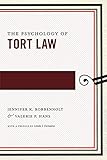The Psychology of Tort Law / Valerie P. Hans, Jennifer K. Robbennolt.
Material type: TextSeries: Psychology and the Law ; 2Publisher: New York, NY : New York University Press, [2016]Copyright date: ©2016Description: 1 online resourceContent type:
TextSeries: Psychology and the Law ; 2Publisher: New York, NY : New York University Press, [2016]Copyright date: ©2016Description: 1 online resourceContent type: - 9780814724941
- 9780814724712
- 346.03019 23
- KF1251 .R62 2017
- online - DeGruyter
| Item type | Current library | Call number | URL | Status | Notes | Barcode | |
|---|---|---|---|---|---|---|---|
 eBook
eBook
|
Biblioteca "Angelicum" Pont. Univ. S.Tommaso d'Aquino Nuvola online | online - DeGruyter (Browse shelf(Opens below)) | Online access | Not for loan (Accesso limitato) | Accesso per gli utenti autorizzati / Access for authorized users | (dgr)9780814724712 |
Browsing Biblioteca "Angelicum" Pont. Univ. S.Tommaso d'Aquino shelves, Shelving location: Nuvola online Close shelf browser (Hides shelf browser)

|

|

|

|

|

|

|
||
| online - DeGruyter Two Presidents Are Better Than One : The Case for a Bipartisan Executive Branch / | online - DeGruyter Slavery before Race : Europeans, Africans, and Indians at Long Island's Sylvester Manor Plantation, 1651-1884 / | online - DeGruyter Latino Urbanism : The Politics of Planning, Policy and Redevelopment / | online - DeGruyter The Psychology of Tort Law / | online - DeGruyter Called to Serve : A History of Nuns in America / | online - DeGruyter Historically Black : Imagining Community in a Black Historic District / | online - DeGruyter Jewish Concepts of Scripture : A Comparative Introduction / |
Frontmatter -- Contents -- Preface -- Acknowledgments -- Introduction -- 1. The Real World of Torts -- 2. Intentional Torts -- 3. Negligence -- 4. Causation -- 5. Limits on Liability: Duty and Scope of Liability -- 6. Damages -- 7. Defenses -- 8. Products Liability -- Conclusion: A Psychological Perspective on Tort Rules, Tort Cases, and Tort Reform -- Appendix: Psychology and Torts -- Notes -- Subject Index -- Name Index -- About the Authors
restricted access online access with authorization star
http://purl.org/coar/access_right/c_16ec
Tort law regulates most human activities: from driving a car to using consumer products to providing or receiving medical care. Injuries caused by dog bites, slips and falls, fender benders, bridge collapses, adverse reactions to a medication, bar fights, oil spills, and more all implicate the law of torts. The rules and procedures by which tort cases are resolved engage deeply-held intuitions about justice, causation, intentionality, and the obligations that we owe to one another. Tort rules and procedures also generate significant controversy-most visibly in political debates over tort reform.The Psychology of Tort Law explores tort law through the lens of psychological science. Drawing on a wealth of psychological research and their own experiences teaching and researching tort law, Jennifer K. Robbennolt and Valerie P. Hans examine the psychological assumptions that underlie doctrinal rules. They explore how tort law influences the behavior and decision-making of potential plaintiffs and defendants, examining how doctors and patients, drivers, manufacturers and purchasers of products, property owners, and others make decisions against the backdrop of tort law. They show how the judges and jurors who decide tort claims are influenced by psychological phenomena in deciding cases. And they reveal how plaintiffs, defendants, and their attorneys resolve tort disputes in the shadow of tort law. Robbennolt and Hans here shed fascinating light on the tort system, and on the psychological dynamics which undergird its functioning.
Mode of access: Internet via World Wide Web.
In English.
Description based on online resource; title from PDF title page (publisher's Web site, viewed 06. Mrz 2024)


